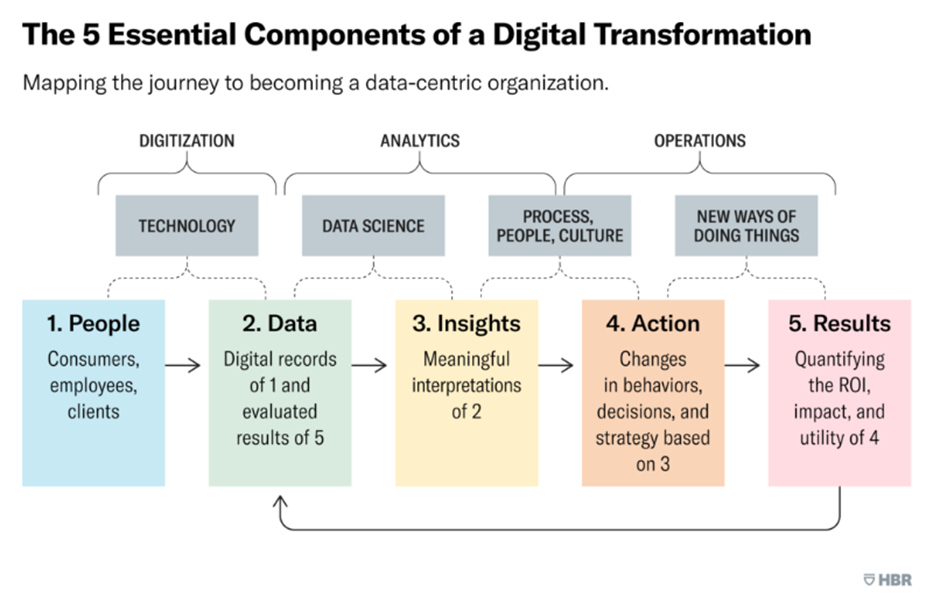Goal
Develop an in-depth overview of emerging digital innovations, exploring their role and impact in enhancing business efficiency and shaping the current socio-economic landscape.
Develop an in-depth overview of emerging digital innovations, exploring their role and impact in enhancing business efficiency and shaping the current socio-economic landscape.
Digital innovation stands as an omnipresent and transformative force within contemporary society, permeating multifaceted dimensions of human existence. This phenomenon encompasses a wide spectrum of technological advancements geared towards streamlining processes and augmenting the quality of life. Ranging from the utilization of Cloud storage to enable remote work amidst the Covid pandemic to the integration of Artificial Intelligence, automation, and e-commerce, digital innovation continues its evolutionary trajectory, underpinned by the overarching objective of maximizing technological progress.
The genesis of digital innovation traces its roots back to the 1970s, characterized by the conceptual shift from analog to digital paradigms. While foundational elements such as the internet, digital technologies, and computer science emerged during the 1970s and 1980s, it wasn't until the 2000s that the pervasive influence of digitalization began to assert itself, with the primary aim of simplifying contemporary lifestyles.
Contemporary vernacular, such as Artificial Intelligence, Big Data, Machine Learning, and Data Science, has revolutionized virtually every facet of societal interaction, particularly within the domains of labor and economics. Nonetheless, it is imperative to recognize that digital innovation transcends mere technological advancements; it encompasses the provision of services, goods, and tools designed to enhance the quality of life across diverse spectrums. This paradigm shift embodies a systematic reconfiguration that disrupts conventional methodologies, fostering a competitive edge through the strategic application of digital technologies to optimize business processes, innovate products or services, and adapt to the dynamic demands of the market.
Furthermore, the inherently dynamic nature of digital innovation necessitates a perpetual pursuit of curiosity, experimentation, and an adaptive mindset. Synchronizing with the ever-evolving landscape demands not only the embracement of emerging technologies but also the establishment of a conducive infrastructure that fosters the flourishing of digital innovation.
In essence, digital innovation embodies an ongoing journey of exploration and knowledge acquisition, driven by the continuous study of emerging technologies and their strategic deployment to maximize utility. It epitomizes the progressive digitization of societal and business frameworks, evolving since its inception in the 1970s and yielding substantial outcomes that significantly shape both present realities and future trajectories.
So, the impact of digital innovation on business sectors and society is significant and multifaceted. It refers to the strategic and integrated use of digital technologies to enhance business operations, develop new products and services, improve customer experience, and adapt to evolving market dynamics. This process entails a systematic overhaul of traditional methodologies, fostering competitiveness and growth. However, it extends beyond mere technological implementation, involving strategic decision-making and organizational change.
True digital innovators are those who continuously adapt to the dynamic competitive landscape, proactively seeking innovative solutions. However, this is an iterative process that requires continuous experimentation, learning, and adaptation to stay ahead of rapid technological advancements and shifting market demands.
Fostering a culture of digital innovation within organizations is crucial, creating an environment that encourages creativity, collaboration, and risk-taking. Establishing the necessary infrastructure, including robust digital platforms and resources, is essential to support and sustain successful digital innovation initiatives.
This digital transformation delivers significant improvements in efficiency and productivity for businesses, enabling them to focus on higher-value activities through the adoption of cutting-edge technologies such as AI, edge computing, and IoT. Furthermore, it makes businesses more agile and resilient, able to quickly adapt to changing market conditions and environmental shifts.
Digitalization also provides the opportunity to rapidly expand products into new markets, improving the efficiency of the research and development process. This translates into a competitive advantage through synergy between internal talent, advanced technologies, and automation.
The creation of new business value and the introduction of innovative products to the market are made possible by adopting adaptable business models that flexibly respond to market needs and explore new growth opportunities. Tools such as data-driven approaches, upselling, cross-selling, and intelligent technology utilization are essential for achieving successful business models.
Finally, digital transformation significantly enhances communication and customer support, through automated interactions and the provision of additional services. This fosters customer loyalty and contributes to the development of strong, long-lasting relationships, essential for the long-term success of businesses.
The essence of digital transformation lies not solely in its digital aspects but in the profound process of transformation itself. Over the past two decades, our world has undergone significant shifts, rendering it imperative for organizations to adapt accordingly. This adaptation cannot be achieved through hasty overnight changes or the mere acquisition of new technologies or data accumulation. Instead, what is crucial is a fundamental shift in mindset, culture, and talent within organizations, necessitating the upskilling and reskilling of the workforce to ensure their readiness for the future.

In considering digital transformation, there are five fundamental elements that cannot be overlooked in the context of change:
Despite these transformative changes, one aspect remains constant: the timeless responsibility of leaders to prepare their teams and organizations for the future and to facilitate progress.
Falso
Verdadeiro
Verdadeiro
Falso
Falso
Verdadeiro
Falso
Falso
Verdadeiro
Falso
Licenciado baixo a Licenza Creative Commons Atribución Compartir igual 4.0